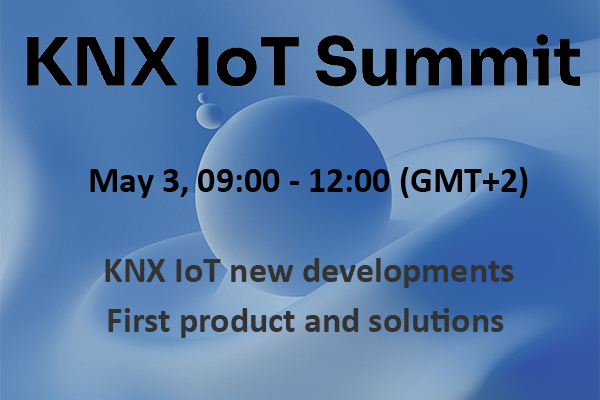The recent KNX IoT Keynote Event kicked off the official launch of KNX IoTech with an overview of the technology and how it can be applied. Ahead of the KNX IoT Summit on 3 May 2022, which will go into more depth, KNX Association CTO, Joost Demarest summarises what KNXIoTech is and its benefits, whilst KNX Association Membership & Business Development Manager, Jesus Arias, describes its first implementation.

KNXtoday to Joost Demarest: What is KNX IoTech and what are its aims?
JD: KNX IoTech is a collective term for alternative ways to create KNX IP solutions, be it hardware- or software-based. It is true that such solutions already exist, but they are mainly manufacturer-specific and require specific KNX knowledge by the developer in order to create the solution.

KNX IoTech has three main goals:
• Making sure that all manufacturers communicate via a common API with KNX installations. The common API is called ‘KNX IoT 3rd Party API’.
• Making sure that with this common API, standard IP protocols (http) and common IT security mechanisms are used, not the KNX-specific KNX Secure.
• Allowing other IPv6 networks, for example Thread, to be used as communication networks for KNX communication, also using standard IP protocols, including CoAp (Constrained Application Protocol). This is called ‘KNX IoT Point API’.
The benefit to the user is speedier development of KNX IP solutions – hence more KNX solutions.
KNXtoday: What’s the difference between the KNX IoT 3rd Party API and other home automation connectivity standards such as Matter?
JD: Matter will not offer a comparable solution to the KNX IoT 3rd Party API. Matter will offer a solution comparable to KNX IoT Point API, however the Point API already includes the usual mechanisms for a standardised configuration of such devices with ETS. So, the Point API devices will immediately be able to use the vast standardised application profiles that have been designed over the more than three decades of KNX’ existence, be it in the home or other building.
It is not the intention that KNX IoTech will make existing KNX IP solutions redundant. KNX IoTech simply provides more technical means to realise KNX IP solutions. By having the KNX IoT 3rd Party API, it will become easier to interface to other systems, e.g. to Matter. And by the fact that Matter and Point API are based on the very same standard IP protocols, this interfacing will also become much easier.
KNXtoday: How could ETS benefit from KNX IoTech?
JD: One of the main topics as part of the KNX IoTech project is semantics: in layperson terms, it is all about adding meaning to data, so that this can be more easily interpreted by machines. One such machine could be ETS during the project planning and design phase. If manufacturers add this additional semantic data to their product data, by simply selecting the building functions one wishes to realise in a home or building, one could already make a rudimentary ETS project, even in external tools. Also, ETS could make use of this semantic data to ensure quicker linking between similar functions of different products from different manufacturers.
For more information go to www.knx-iotech.org.
KNXtoday to Jesus Arias: What’s the latest on the first KNX IoTech solution?
JA: This is a dream come true thanks to the efforts of two of our KNX Members, namely Schneider Electric and Simlab, who have worked hard to launch the first KNX IoT 3rd Party joint solution: a digital twin property based on KNX.

The Simlab SIM-ON solution creates a digital twin, i.e. a tool which integrates both physical and digital worlds, of an existing property, previously scanned using Matterport – a 3D scanning tool for smartphones. It adds a layer of management and information related to the KNX installation. The setup process is quick and easy, thanks among other things to the KNX IoT 3rd Party API server, offered by the Schneider Wiser for KNX. This combination results in an outstanding solution unparalleled in the smart home and building industry. A visualisation with full control over the KNX installation can be set up in a matter of minutes, with the highest quality and superb aesthetics.
KNXtoday: Can you go into more detail about how this was achieved?
JA: To create this solution, we need to consider the two parts used in a KNX IoT 3rd Party API, namely the server and the client.
For the KNX IoT 3rd Party API server, the Schneider Electric Wiser for KNX is a server that has been on the market for several years, and offers an environment to create visualisations, build logic and provide other server-related features. It is the first server offering the KNX IoT 3rd Party API server functionality. Thanks to this feature, Schneider Electric can create its own software clients to communicate with the server, using the most advanced KNX technology developed to the date, namely a standardised API. Additionally, the manufacturer can open the KNX IoT 3rd Party API server to third parties, enabling unprecedented cooperation between KNX Members, who can enjoy the benefits of a standardised solution resulting in faster developments and smoother integration, and thereby reducing development costs.
For the KNX IoT 3rd Party API client, the SIMLAB SIM-ON software solution consists of a visualisation environment based on a 3D reconstruction of the property. This model adds an interaction layer with the user, such as storage of information on assets such as invoices and manuals, or control of the existing systems. Thanks to the KNX IoT 3rd Party API technology, SIMLAB was able to add connectivity to KNX installations in record time, which enabled a new dimension of control and interaction. This abstraction from the KNX-specific knowledge resulted in less training required, reducing the investment and speeding up time to market.
For more information, see the KNX IoT case study: Digital Twin property
KNX IoT Summit
The KNX IoT Summit will take place on 3 May between 09:00 – 12:00 (GMT+2). For a list of speakers, schedule highlights and to register, click here.













